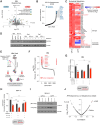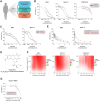This is a preprint.
Riboflavin drives nucleotide biosynthesis and iron-sulfur metabolism to promote acute myeloid leukemia
- PMID: 40666848
- PMCID: PMC12262817
- DOI: 10.1101/2025.06.26.661633
Riboflavin drives nucleotide biosynthesis and iron-sulfur metabolism to promote acute myeloid leukemia
Abstract
Riboflavin is a diet-derived vitamin in higher organisms that serves as a precursor for flavin mononucleotide and flavin adenine dinucleotide, key cofactors that participate in oxidoreductase reactions. Here, using proteomic, metabolomic and functional genomics approaches, we describe a specific riboflavin dependency in acute myeloid leukemia and demonstrate that, in addition to energy production via oxidative phosphorylation, a key biological role of riboflavin is to enable nucleotide biosynthesis and iron-sulfur cluster metabolism. Genetic perturbation of riboflavin metabolism pathways or exogenous depletion in physiological culture medium induce nucleotide imbalance and DNA damage responses, as well as impair the stability and activity of proteins which utilize [4Fe-4S] iron-sulfur clusters as cofactors. We identify a window of therapeutic opportunity upon riboflavin starvation or chemical riboflavin metabolism perturbation and demonstrate that this strongly synergizes with BCL-2 inhibition. Our work identifies riboflavin as a critical metabolic dependency in leukemia, with functions beyond energy production.
Conflict of interest statement
S. Bjelosevic is a current equity holder in Ramsay Healthcare Ltd. D.E. Root receives research funding from Abbvie, BMS, Janssen and Merck, and is a member of the Board of Directors of Addgene, Inc. M.G. Vander Heiden is on the scientific advisory board of Agios Pharmaceuticals, iTeos Therapeutics, Drioa Ventures, Sage Therapeutics, Lime Therapeutics, Pretzel Therapeutics, and Auron Therapeutics, and is on the advisory board of Developmental Cell. K. Stegmaier received grant funding from Novartis and consults for and has stock options with Auron Therapeutics.
Figures






References
Publication types
Grants and funding
LinkOut - more resources
Full Text Sources
